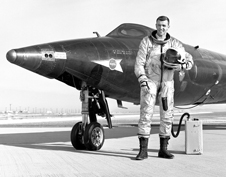March 31, 2010 Vol. 3, Issue 3
The X-15 yielded valuable information for the development of the space shuttle, according to Major General Joe Engle, the only pilot to fly both vehicles.

Joe Engle standing next to the X-15-2 rocket plane in 1965. Image Credit: NASA
Thirty-one-year-old Joe Engle looked to his left to see the oblique side of the B-52 carrying him inside the X-15 rocket plane. He flipped a switch to release cold nitrogen gas into the cockpit (a precaution for fire hazards) one minute before launch. When the seconds ticked down to zero, he released himself from the underside of the B-52’s wing, hit the throttle and flipped each of the eight switches on the left-hand-side of the cockpit to ignite the engines, slamming his body back against his chair with 2gs of force.
For the next 87 seconds the engines powered the 50-foot-long X-15 rocket plane before shutting down. The plane then soared out of Earth’s atmosphere and into space. After a few minutes of weightlessness, Engle repositioned the plane to enter the atmosphere at just the right angle to avoid skipping off the top of the atmosphere like a rock across water. The rest of the flight was a sustained glide.
He looked out his windows to guide his landing into the dry lakebed at Edwards Air Force Base, and jerked the landing gear lever with the 20 pounds of required force to release the skids at the back of the plane. The skids touched down at speeds of 200 miles per hour, followed by the nose of the aircraft.

Video: Short clip of the X-15 being dropped from the B-52 and taking flight. Video Credit: NASA Dryden Flight Research Center
“It was a really ugly thing,” recalled Engle, speaking before a crowd in the auditorium at NASA Headquarters in February. “You just kind of made sure that your teeth were together when the nose started down. It was a pretty good smack.”
The entire flight lasted a total of ten minutes. “From launch to touchdown, I can remember flights…where I would be sliding to a stop, and I would be thinking, ‘What happened? What did I just do?'”
Engle broke the sound barrier sixteen times, and in 1965 he became the youngest person to receive his astronaut wings. Twelve years later, he commanded the second test-flight of the space shuttle Enterprise, and went on to command STS-2 and STS-51I, clocking a total of 224 hours in space.
The X-15 was the last in a series of X-planes designed in the 1940s and 1950s that shattered the existing boundaries of flight. Unlike earlier planes starting with the X-1, which focused solely on speed, the X-15’s objectives included both altitude and speed. It was a collaborative effort among the Air Force, Navy, and the newly formed NASA. “If I didn’t look at badges, I would not know who anybody worked for on that program,” Engle said. “It was that kind of operation.”
At the dawn of the age of space flight, the aerodynamic heating loads that the plane experienced were of particular interest to engineers. As the X-15 reentered the atmosphere, it increased in length by over three inches. During the expansion, “it [sounded] like someone is banging against the side of the plane with a sledgehammer….The old guys wouldn’t tell you about that,” laughed Engle. “They’d let you learn that on your own.” The X-15 also informed designers about flight control systems for re-entry. In space, the X-15 could fly right-side-up or upside-down. Upon re-entry, however, flight positioning was critical — otherwise the plane would skip in and out of the atmosphere. (The longest X-15 flight was flown by Neil Armstrong, whose plane experienced skipping. He recovered control and was able to make a successful landing 45 miles south of Edwards.)
When designing the X-15, explained Engle, engineers thought that there would be “a magic altitude where you’ll want to quit flying with the aerodynamic surfaces and start flying with the reaction controls.” They estimated this would happen around 240,000 to 250,000 feet. The engineers tasked the pilots with determining where this magic altitude was during their flights as they left and re-entered the atmosphere.
Some pilots had a smooth transition between the two systems, while others didn’t. For a long time, pilots and engineers thought that it had to do with the way that the plane was rigged, but this wasn’t case. It turned out that there was no magic altitude — the atmosphere is gradual. “We learned that a blended adaptive flight control system really is…necessary for an entry from space back into the atmosphere.” The shuttle today uses a flight control system similar in design to the one on the X-15.
Another important lesson learned from the X-15 program was having a chaser airplane following to assist with the glide and landing. The chase plane used for the shuttle during re-entry tells the shuttle crew how high above the ground its wheels are. Engle said that compared to the shuttle, the X-15 felt like sliding back down to Earth on a skateboard.
Finally, knowledge from the X-15 about energy management — balancing the right amount of energy and speed to land the aircraft in the correct place — informed the development of the shuttle. “People didn’t think we could land the shuttle without a bit of powered flight,” said Engle. Some engineers were concerned about the lift-to-drag ratio on the shuttle, so they designed an engine that would rise out of the payload area (taking up one-third of the bay) to power the shuttle to the ground. Fortunately for the payload people, remarked Engle, the engine never flew. The re-entry flight patterns for both the X-15 and shuttle are nearly identical — and un-powered.
The X-15 program ended in 1968 after 199 flights. To this day, it is considered to be one of the most successful flight research programs in the history of aviation. “I feel so fortunate to be a part of that time,” said Engle.





